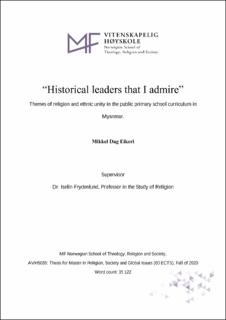“Historical leaders that I admire” : themes of religion and ethnic unity in the public primary school curriculum in Myanmar
Master thesis
Permanent lenke
https://hdl.handle.net/11250/2732999Utgivelsesdato
2020Metadata
Vis full innførselSamlinger
Sammendrag
This thesis is written to provide an understanding of how themes of religion and ethnic unity are addressed to children in the Burmese primary schools. By analysing the curriculum texts from three different grades teaching the subject ‘Sociology’, I have analysed the presentations of historical leaders in these textbooks. My research question is: How are themes of religion and ethnic unity (re)presented in primary school textbooks in Myanmar? My aim is to further understand how these themes are present in the presentation of historical figures, leaders whom are presented as admirable, in Burmese history. Myanmar has a complicated history, and a complicated political situation. Its population spans many different ethnic groups and several religious traditions, yet the curriculum does not reflect this diversity. By conducting a discourse analysis, I have looked at how religion and ethnic unity are present, or if they are absent from the curriculum texts. In order to conduct my analysis, I have used four different theories: 1) Formatting religion, to understand how the content and understanding of religion may change by the way it is presented, 2) hidden curriculum, in order to look at underlying ideas and norms that are not a part of the ‘official’ curriculum, 3) theory on the use of images to explain how meaning is convey through images used in the text, and 4) Myanmafication/Burmanisation, in order to further understand the theme of ethnic unity and how it relates to the Burmese military. My conclusion is that there are plenty of references to the religion and ethnic unity in the curriculum texts. However, each of the references to religion addresses Buddhism alone, while ethnic unity is only presented from the perspective of the majority group where a monarch or general is honored for his or her ability to unite all the ethnic peoples. Other religious views and ethnic groups are omitted from the text, and in this way the textbooks present Buddhism and the incorporation into the majority ethnic group as ideals and accomplishments to be admired.
